CD4+ T cells promote humoral immunity and viral control during Zika virus infection
- PMID: 30677097
- PMCID: PMC6345435
- DOI: 10.1371/journal.ppat.1007474
CD4+ T cells promote humoral immunity and viral control during Zika virus infection
Erratum in
-
Correction: CD4+ T cells promote humoral immunity and viral control during Zika virus infection.PLoS Pathog. 2019 May 28;15(5):e1007821. doi: 10.1371/journal.ppat.1007821. eCollection 2019 May. PLoS Pathog. 2019. PMID: 31136625 Free PMC article.
Abstract
Several Zika virus (ZIKV) vaccines designed to elicit protective antibody (Ab) responses are currently under rapid development, but the underlying mechanisms that control the magnitude and quality of the Ab response remain unclear. Here, we investigated the CD4+ T cell response to primary intravenous and intravaginal infection with ZIKV. Using the LysMCre+Ifnar1fl/fl (myeloid type I IFN receptor-deficient) C57BL/6 mouse models, we identified six I-Ab-restricted ZIKV epitopes that stimulated CD4+ T cells with a predominantly cytotoxic Th1 phenotype in mice primed with ZIKV. Intravenous and intravaginal infection with ZIKV effectively induced follicular helper and regulatory CD4+ T cells. Treatment of mice with a CD4+ T cell-depleting Ab reduced the plasma cell, germinal center B cell, and IgG responses to ZIKV without affecting the CD8+ T cell response. CD4+ T cells were required to protect mice from a lethal dose of ZIKV after infection intravaginally, but not intravenously. However, adoptive transfer and peptide immunization experiments showed a role for memory CD4+ T cells in ZIKV clearance in mice challenged intravenously. These results demonstrate that CD4+ T cells are required mainly for the generation of a ZIKV-specific humoral response but not for an efficient CD8+ T cell response. Thus, CD4+ T cells could be important mediators of protection against ZIKV, depending on the infection or vaccination context.
Conflict of interest statement
The authors have declared that no competing interests exist.
Figures
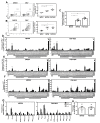
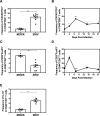
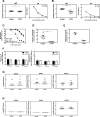
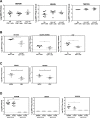
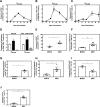
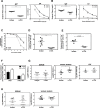
Similar articles
-
CD4+T cells mediate protection against Zika associated severe disease in a mouse model of infection.PLoS Pathog. 2018 Sep 13;14(9):e1007237. doi: 10.1371/journal.ppat.1007237. eCollection 2018 Sep. PLoS Pathog. 2018. PMID: 30212537 Free PMC article.
-
Mapping and Role of the CD8+ T Cell Response During Primary Zika Virus Infection in Mice.Cell Host Microbe. 2017 Jan 11;21(1):35-46. doi: 10.1016/j.chom.2016.12.010. Cell Host Microbe. 2017. PMID: 28081442 Free PMC article.
-
In silico construction of a multiepitope Zika virus vaccine using immunoinformatics tools.Sci Rep. 2022 Jan 7;12(1):53. doi: 10.1038/s41598-021-03990-6. Sci Rep. 2022. PMID: 34997041 Free PMC article.
-
Current Understanding of the Role of T Cells in Chikungunya, Dengue and Zika Infections.Viruses. 2022 Jan 25;14(2):242. doi: 10.3390/v14020242. Viruses. 2022. PMID: 35215836 Free PMC article. Review.
-
Protective to a T: The Role of T Cells during Zika Virus Infection.Cells. 2019 Aug 3;8(8):820. doi: 10.3390/cells8080820. Cells. 2019. PMID: 31382545 Free PMC article. Review.
Cited by
-
Immunity to TBEV Related Flaviviruses with Reduced Pathogenicity Protects Mice from Disease but Not from TBEV Entry into the CNS.Vaccines (Basel). 2021 Feb 26;9(3):196. doi: 10.3390/vaccines9030196. Vaccines (Basel). 2021. PMID: 33652698 Free PMC article.
-
Zika Virus-A Reemerging Neurotropic Arbovirus Associated with Adverse Pregnancy Outcomes and Neuropathogenesis.Pathogens. 2024 Feb 15;13(2):177. doi: 10.3390/pathogens13020177. Pathogens. 2024. PMID: 38392915 Free PMC article. Review.
-
NK cells require immune checkpoint receptor LILRB4/gp49B to control neurotropic Zika virus infections in mice.JCI Insight. 2022 Feb 8;7(3):e151420. doi: 10.1172/jci.insight.151420. JCI Insight. 2022. PMID: 35132958 Free PMC article.
-
An optimized purified inactivated Zika vaccine provides sustained immunogenicity and protection in cynomolgus macaques.NPJ Vaccines. 2020 Mar 12;5(1):19. doi: 10.1038/s41541-020-0167-8. eCollection 2020. NPJ Vaccines. 2020. PMID: 32194996 Free PMC article.
-
A live-attenuated viral vector vaccine protects mice against lethal challenge with Kyasanur Forest disease virus.NPJ Vaccines. 2021 Dec 14;6(1):152. doi: 10.1038/s41541-021-00416-2. NPJ Vaccines. 2021. PMID: 34907224 Free PMC article.
References
-
- Freour T, Mirallie S, Hubert B, Splingart C, Barriere P, Maquart M, et al. Sexual transmission of Zika virus in an entirely asymptomatic couple returning from a Zika epidemic area, France, April 2016. Euro Surveill. 2016;21(23). Epub 2016/06/18. 10.2807/1560-7917.ES.2016.21.23.30254 . - DOI - PubMed
Publication types
MeSH terms
Substances
Grants and funding
LinkOut - more resources
Full Text Sources
Other Literature Sources
Medical
Research Materials

